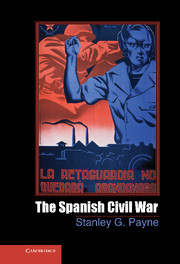Book contents
- Frontmatter
- Contents
- Chronology of Major Events
- Glossary
- Preface
- Introduction Civil War in Twentieth-Century Europe
- 1 Modernization and Conflict in Spain
- 2 From Revolutionary Insurrection to Popular Front
- 3 The Breakdown of Democracy
- 4 The Military Insurrection of the Eighteenth of July
- 5 The Battle of Madrid – the First Turning Point
- 6 Revolution
- 7 Terror
- 8 A War of Religion
- 9 Franco's Counterrevolution
- 10 Foreign Intervention and Nonintervention
- 11 Soviet Policy in Spain, 1936–1939
- 12 The Propaganda and Culture War
- 13 A Second Counterrevolution? The Power Struggle in the Republican Zone
- 14 The Decisive Northern Campaigns of 1937–1938
- 15 The War at Sea and in the Air
- 16 Civil Wars within a Civil War
- 17 The War in Perspective
- Conclusion Costs and Consequences
- Select Bibliography
- Index
- References
11 - Soviet Policy in Spain, 1936–1939
Published online by Cambridge University Press: 05 September 2012
- Frontmatter
- Contents
- Chronology of Major Events
- Glossary
- Preface
- Introduction Civil War in Twentieth-Century Europe
- 1 Modernization and Conflict in Spain
- 2 From Revolutionary Insurrection to Popular Front
- 3 The Breakdown of Democracy
- 4 The Military Insurrection of the Eighteenth of July
- 5 The Battle of Madrid – the First Turning Point
- 6 Revolution
- 7 Terror
- 8 A War of Religion
- 9 Franco's Counterrevolution
- 10 Foreign Intervention and Nonintervention
- 11 Soviet Policy in Spain, 1936–1939
- 12 The Propaganda and Culture War
- 13 A Second Counterrevolution? The Power Struggle in the Republican Zone
- 14 The Decisive Northern Campaigns of 1937–1938
- 15 The War at Sea and in the Air
- 16 Civil Wars within a Civil War
- 17 The War in Perspective
- Conclusion Costs and Consequences
- Select Bibliography
- Index
- References
Summary
Soviet policy in Spain became as controversial as the German intervention, and was more complex, with a major internal political dimension in addition to the Soviet military role. It also formed part of a broader international strategy more complicated than that of Germany. Unlike the Axis powers, the Soviet Union had been attempting to intervene in Spanish politics ever since Soviet agents had taken the initiative in organizing the Spanish Communist Party (PCE) in 1920. By contrast, Italian policy prior to the war had been directed primarily to cultural affairs, although Rome provided a modest subsidy to the Falange in 1935–36, after its earlier agreement with monarchists had become a dead letter. The Third Reich had limited itself to comparatively modest propaganda activities.
For fifteen years, the PCE was a complete failure, one of the weakest European Communist parties. There were various schisms and numerous changes in the party leadership, until in October 1932 the Communist International (Comintern) appointed the ex-anarchist José Díaz secretary general. He led a new team composed of such figures as Vicente Uribe and the very young Jesús Hernández, together with the party's first woman luminary, the eloquent Vizcayan propagandist and head of the women's section, Dolores Ibárruri (“Pasionaria”), who would become the best-known Communist during the civil war. These new leaders were tough, resourceful, hardworking, disciplined, and loyal to Moscow. They would provide determined and effective direction in the dramatic struggles that followed.
- Type
- Chapter
- Information
- The Spanish Civil War , pp. 149 - 159Publisher: Cambridge University PressPrint publication year: 2012

